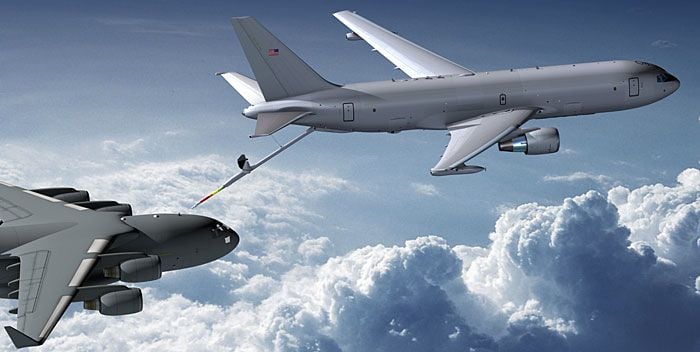Long Troubled Tanker Program May Be Turning Corner; Costs Down Half Billion Dollars
Posted on
PENTAGON: One of the most screwed up programs in Pentagon history, the airborne tanker, may have turned a corner, with the KC-46 program cutting more than half-a-billion dollars from its projected costs, with $386.9 million of those savings coming in fiscal 2015. Some of these details will doubtless be discussed at the Wednesday afternoon House Armed Services subcommittee hearing about the tanker and other Air Force projection assets such as the C-5 and C-17.
The cost declined as the Air Force added five tanker aircraft to its 2015 budget plan, albeit in the out years.
|
KC-46 FY15 President’s Budget (TY$M) |
||||||
| FY15 | FY16 | FY17 | FY18 | FY19 | Total FYDP | |
| FY15 PB | $2,546.9 | $3,075.2 | $4,271.4 | $4,026.4 | $3,663.7 | $17,583.6 |
| FY14 PB | $2,933.8 | $3,697.0 | $3,809.9 | $3,718.0 | $3,973.8 | $18,132.5 |
| Delta | ($386.9) | ($621.8) | $461.5 | $308.4 | ($310.1) | ($548.9) |
We asked the program office how this apparent goodness happened, given the program’s long history of cock-ups.
Their answer: “The Program was able to reduce the funding over the FYDP (Future Years Defense Plan) due to: 1) a competitively awarded Aircrew Training Systems (ATS) contract in May 2013 ($250M savings), and 2) overall program risk reductions ($656M) given the program’s assessment, continued stability in execution, and the fact that no engineering change orders have been executed on the Boeing aircraft development contract.
Other refinements include: 1) Lowered MILCON costs ($651M) based on site surveys and knowledge gained since contract award, and 2) DoD budgetary adjustment for deflation ($132M).”
The program tries to make the case look even better by noting that the cost savings came even with three planes being added to fiscal 2017 and two to fiscal 2018 as part of the Future Years Defense Plan. which added $1.14 billion.
A congressional aide was careful to grant the program and the Air Force some credit: “I look at the ATS savings as tangible; the ‘risk reduction’ savings I consider a guess of what we may not need, but not actually realized yet (so proceed with caution) since it’s in the FYDP….and anything is possible in the FYDP…”
The aide was less charitable about the $651 million reduction in military construction spending. That, the aide writes, “is likely the program just having to live with current infrastructure with no ability to build new and they’ll have to live with what’s already built.”
As to those added aircraft? That, our Hill source says, “is funny money and part of the $115B above sequestration caps, so low likelihood that will ever come to fruition.”
So is the KC-46 really doing better and saving taxpayers some money after more than a decade of disastrous decisions by senior Air Force leaders?
“Bottomline, the program is executing well,” the congressional aide says, “but with only 50% of it complete and they still haven’t flown yet, still a long ways to go to say that they won’t not need the risk funding put back in the future; there’s always discovery during flight test.” The Air Force gets credit for having “exhibited discipline in no requirements creep and holding the contractor accountable for projected cost growth above the government’s liability of $4.8M ceiling.”
The KC-46 program may not have ‘turned the corner just yet, but they definitely do have their blinker on indicating they plan to make a turn.”
I’m betting the Air Force will be pretty happy with that characterization
Subscribe to our newsletter
Promotions, new products and sales. Directly to your inbox.

